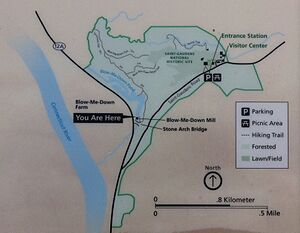Saint-Gaudens National Historical Park facts for kids
|
Saint-Gaudens National Historical Park
|
|

Interior of the studio of Augustus Saint-Gaudens in Cornish, N.H.
|
|
| Location | Cornish, New Hampshire |
|---|---|
| Area | 370 acres (150 ha) 195 acres (79 ha) federal |
| Built | 1817 (main house) |
| Built by | Augustus Saint-Gaudens |
| Visitation | 26,943 (2005) |
| NRHP reference No. | 66000120 (original) 13000802 (increase) |
Quick facts for kids Significant dates |
|
| Added to NRHP | October 15, 1966 |
| Boundary increase | October 2, 2013 |
| Designated NHS | August 31, 1964 |
| Designated NHLD | June 13, 1962 |
The Saint-Gaudens National Historical Park in Cornish, New Hampshire, is a special place. It protects the home, gardens, and art studios of Augustus Saint-Gaudens. He was one of America's most famous sculptors from the late 1800s and early 1900s.
This park was his summer home from 1885 to 1897. Later, it became his full-time home from 1900 until he passed away in 1907. It was also a hub for many other artists in the area. Today, you can explore three hiking trails that wind through the park's beautiful nature. You can also see his original sculptures and copies of his most famous works. The park is easy to find on Saint-Gaudens Road in Cornish.
Contents
The Story of Aspet: Saint-Gaudens' Home
Augustus Saint-Gaudens bought this property in 1885. A friend, Charles Cotesworth Beaman Jr., encouraged him to move there. Beaman had already bought a nearby farm for his own summer home. Saint-Gaudens named his new retreat "Aspet." This name came from the town in France where his father was born.
He set up a studio here and created art every summer. From 1900 until his death in 1907, he lived at Aspet all year. After his wife, Augusta, passed away in 1926, the property went to the Saint-Gaudens Memorial. This group had been started by Augusta in 1919. The Memorial ran Aspet as a museum from 1927. Then, in 1965, it was given to the National Park Service (NPS). The Memorial still helps the park today. They support its care and offer fun public programs.
Becoming a National Park
The estate was recognized as a National Historic Landmark in 1962. This means it's a very important historical place. In 1964, Congress officially made it the Saint-Gaudens National Historic Site. It became a full National Historical Park in 2019.
This park is unique because it's the only NPS site in New Hampshire, besides a part of the Appalachian National Scenic Trail. Over time, the NPS added more land to the park. This included "Blow-Me-Down-Farm," which was once owned by Saint-Gaudens' friend, Charles Beaman Jr.
Exploring the Park's Beauty
The main attractions at Aspet are the historic house and the Little Studio. The main house was built around 1816-1817. Saint-Gaudens made many changes to it over the years. The Little Studio was built in 1903-1904. It replaced his earlier workspaces.
The park grounds are beautifully designed with hedges and terraced gardens. You can see copies of Saint-Gaudens' sculptures displayed among the plants. He designed these gardens himself, with help from a landscape architect named Ellen Shipman. There's also a special outdoor area called the Pan Grove. It has a green marble pool and a statue of the Greek god Pan.
Artists Who Live and Work Here
Since 1969, the Saint-Gaudens National Historical Park has had a sculptor-in-residence program. This is the longest-running artist residency in the entire National Park Service! It means sculptors can live and work at the park for a period of time.
American sculptor Lawrence Nowlan was an artist-in-residence for five summers. He worked here from 1995 to 1997 and again from 2001 to 2002. While at Saint-Gaudens, he received his first big art job. He was asked to design the Wildland Firefighters National Monument.
The sculptor-in-residence for 2023-2024 is Davis Fandiño.
See also


